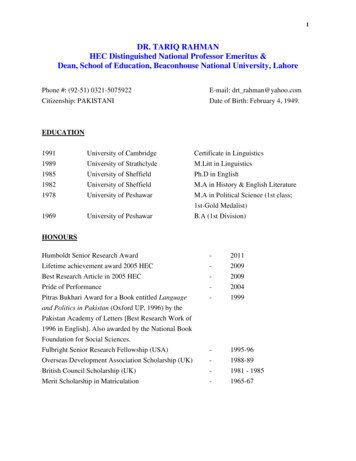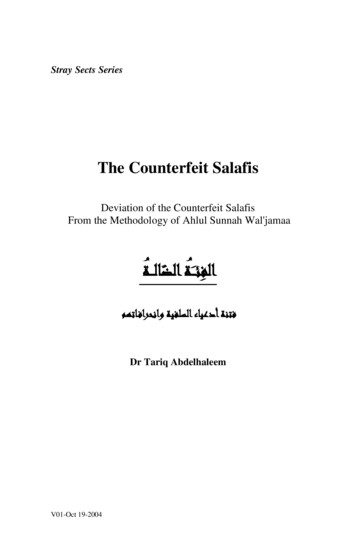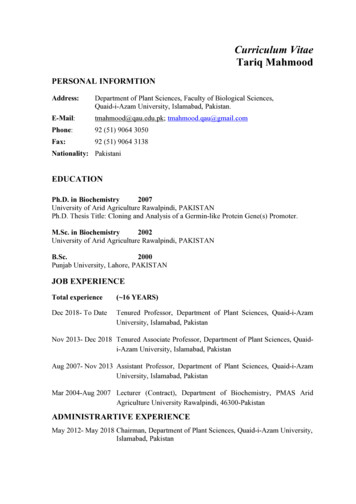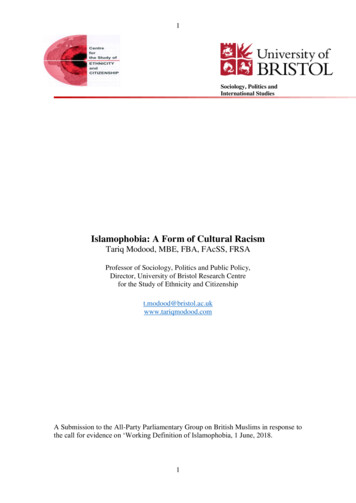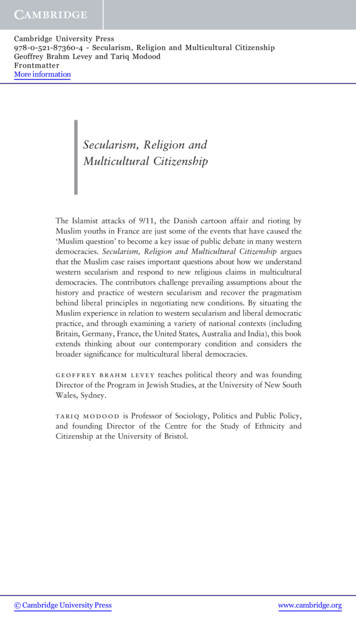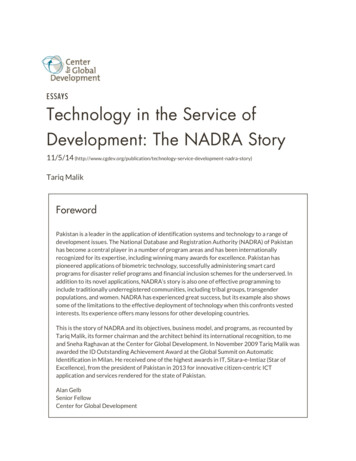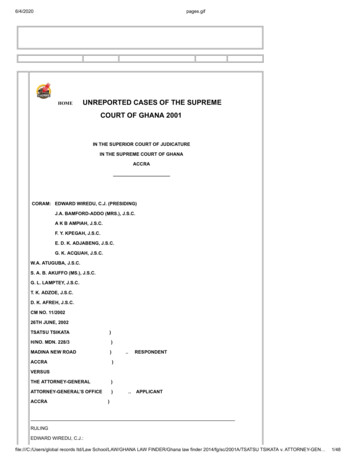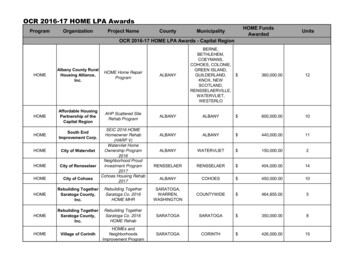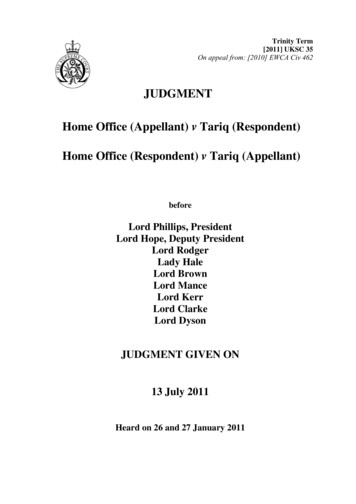
Transcription
Trinity Term[2011] UKSC 35On appeal from: [2010] EWCA Civ 462JUDGMENTHome Office (Appellant) v Tariq (Respondent)Home Office (Respondent) v Tariq (Appellant)beforeLord Phillips, PresidentLord Hope, Deputy PresidentLord RodgerLady HaleLord BrownLord ManceLord KerrLord ClarkeLord DysonJUDGMENT GIVEN ON13 July 2011Heard on 26 and 27 January 2011
AppellantJames Eadie QCCatherine Callaghan(Instructed by TreasurySolicitors)RespondentRobin Allen QCPaul Troop(Instructed by RussellJones & Walker Solicitors)AppellantRobin Allen QCPaul Troop(Instructed by RussellJones & WalkerSolicitors)RespondentJames Eadie QCCatherine Callaghan(Instructed by TreasurySolicitors)Special AdvocateInterveners (JUSTICE andLiberty)John Howell QCNaina Patel(Instructed by HerbertSmith LLP)Judith Farbey QC(Instructed by SpecialAdvocates Support Office)
LORD MANCEIntroduction1.This appeal concerns the permissibility and in particular compatibility withEuropean Union law and Human Rights Convention rights, of a procedure(conveniently described as a “closed material procedure”) whereby an applicantand his representatives may be excluded from certain aspects of employmenttribunal proceedings on grounds of national security, and a special advocate mayrepresent his interests so far as possible in relation to the aspects closed to him andhis representatives.2.In the relevant employment tribunal proceedings, the appellant, Mr KashifTariq, complains that his security clearance as an immigration officer waswithdrawn in circumstances involving direct or indirect discrimination on groundsof race and/or religion, and that this was contrary to the Race Relations Act 1976and the Employment Equality (Religion or Belief) Regulations 2003 (SI2003/1660). The Home Office’s case is that there was no such discrimination, thatthe decisions taken in relation to Mr Tariq were taken for the purposes ofsafeguarding national security, and that the order for a closed material proceduremade by the Employment Tribunal (on the Home Office’s application) on 15February 2008 was made justifiably and for the same protective purposes.3.Mr Tariq’s challenge to the Employment Tribunal’s order for a closedmaterial procedure was dismissed by the Employment Appeal Tribunal on 16October 2009, UKEAT 168/09, [2010] ICR 223 and the Court of Appeal on 4 May2010 [2010] EWCA Civ 462, [2010] ICR 1034, but it was declared (by theEmployment Appeal Tribunal’s order dated 24 November 2009, upheld in theCourt of Appeal) that article 6 of the European Convention on Human Rights“requires [Mr Tariq] to be provided with the allegations being made against him insufficient detail to enable him to give instructions to his legal team so that thoseallegations can be challenged effectively” (a requirement which can convenientlybe described as “gisting”), even if this put the Home Office “in the invidiousposition of having to make difficult decisions about disclosure and whether or howa claim is to be defended”: [2010] ICR 1034, para 50, per Maurice Kay LJ. TheHome Office appeals to the Supreme Court against the latter conclusion, while MrTariq cross-appeals against the conclusion that a closed material procedure waspermissible.Page 2
The factual background in more detail4.Mr Tariq started employment with the Home Office as an immigrationofficer on 21 April 2003, having received the necessary security clearance on 18February 2003. On 19 August 2006 he was suspended from duty on basic pay,while consideration was given to the withdrawal of his security clearance, and on20 December 2006 his clearance was withdrawn. His internal appeal against thisdecision was dismissed on 9 August 2007, and his further appeal to the SecurityVetting Appeals Panel (“SVAP”) was unsuccessful in January 2011.5.The background to the Home Office’s decisions to suspend and withdrawMr Tariq’s security clearance consists in the arrest of his brother and cousin on 10August 2006 during a major counter-terrorism investigation into a suspected plotto mount a terrorist attack on transatlantic flights. Mr Tariq's brother wassubsequently released without charge. Mr Tariq's cousin, Tanvir Hussain, wasconvicted on 8 September 2008 of conspiracy to murder, having previously alsopleaded guilty to two counts of conspiracy to cause explosions and to commit apublic nuisance. He is now serving a sentence of life imprisonment. Inquiries weremade at the time of the arrests to establish whether or not Mr Tariq was involvedin any way with the plot or could be affected by it. No information suggested thatMr Tariq had himself been involved in any terrorism plot, but the Home Office (in“grounds of resistance” served in the Employment Tribunal proceedings on 6August 2007 and amplified on 20 December 2007) states that it was concerned inAugust 2006 “that [Mr Tariq] could be vulnerable to an approach to determine ifterrorist suspects had been flagged to the authorities or to smuggle prohibited itemsairside” and that its decision to withdraw security clearance in December 2006 was“based on [his] close association with individuals suspected of involvement inplans to mount terrorist attacks” and on its view that association with suchindividuals might make him “vulnerable to attempts to exert undue influence on[him] to abuse his position”.6.Mr Tariq commenced the employment tribunal proceedings claiming director indirect discrimination on grounds of race and/or religion on 15 March 2007. Hestated at the outset that he had been advised that his suspension and the withdrawalof his security clearance were because of his perceived association with certainrelatives or associates of relatives suspected of association with terrorist activitiesand the risk of their attempting to exert influence on him to abuse his position. Hedenied any such association or risk. On 10 July 2007 he provided what he saidwere (considering, he said, the “extremely limited information as to the groundsfor his treatment” to that date given) the best further particulars possible to givepending disclosure by the Home Office. These particulars alleged, inter alia, thatthe Home Office had relied upon stereotypical assumptions about him and/orMuslims and/or individuals of Pakistani origin such as susceptibility to undueinfluence, coercion or “brainwashing” and had indirectly discriminatory securityPage 3
policies, procedures and methods of investigation. The Home Office in its groundsof resistance denied this and maintains, as stated, that it acted throughout to protectnational security.The legislation7.The Race Relations Act 1976 provides:“1 Racial discrimination(1) A person discriminates against another in any circumstancesrelevant for the purposes of any provision of this Act if(a) on racial grounds he treats that other less favourably than hetreats or would treat other persons; .(lA) A person also discriminates against another if, in anycircumstances relevant for the purposes of any provision referred toin subsection (lB), he applies to that other a provision, criterion orpractice which he applies or would apply equally to persons not ofthe same race or ethnic or national origins as that other, but(a) which puts or would put persons of the same race or ethnic ornational origins as that other at a particular disadvantage whencompared with other persons,(b) which puts or would put that other at that disadvantage, and(c) which he cannot show to be a proportionate means of achieving alegitimate aim. .42 Acts safeguarding national securityPage 4
Nothing in Parts II to IV shall render unlawful an act done for thepurpose of safeguarding national security if the doing of the act wasjustified by that purpose.”The Race Relations Act 1976 is the means by which the United Kingdom giveseffect to its obligations under Council Directive 2000/43/EC of 29 June 2000 (“theRace Directive”) implementing the principle of equal treatment between personsirrespective of racial or ethnic origin.8.On 27 November 2000 Council Directive 2000/78/EC (“the EmploymentEquality Directive”) established a general framework for equal treatment inemployment and occupation. This led to the making, under section 2 of theEuropean Communities Act 1972, of the Employment Equality (Religion orBelief) Regulations 2003 (“the Employment Equality Regulations”), prohibitingdiscrimination on grounds of religion or belief and providing:“3.—(1) For the purposes of these Regulations, a person (‘A’)discriminates against another person (‘B’) if—(a) on grounds of religion or belief, A treats B less favourably thanhe treats or would treat other persons; or(b) A applies to B a provision, criterion or practice which he appliesor would apply equally to persons not of the same religion or beliefas B, but—(i) which puts or would put persons of the samereligion or belief as B at a particular disadvantagewhen compared with other persons,(ii) which puts B at that disadvantage, and(iii) which A cannot show to be a proportionate meansof achieving a legitimate aim. .Exception for national securityPage 5
24. Nothing in Part II or III shall render unlawful an act done for thepurpose of safeguarding national security, if the doing of the act wasjustified by that purpose.”The issues regarding closed material procedure in more detail9.Employment Tribunals are established under the Employment TribunalsAct 1996. Section 7 entitles the Secretary of State to make “by regulations(‘employment tribunal procedure regulations’) . such provision as appears tohim to be necessary or expedient with respect to proceedings before employmenttribunals”. Section 10, which I set out in the annex to this judgment, specificallyauthorises the making in the interests of national security of regulations providingfor a closed material procedure, either by direction of a minister or by order of theemployment tribunal or judge, and for the appointment by the Attorney General inthat context of a special advocate.10.The Employment Tribunals (Constitution and Rules of Procedure)Regulations 2004 (SI 2004/1861) contain in Schedules 1 and 2 provisions madeunder sections 7 and 10 of the Act. Schedule 1, headed the Employment TribunalsRules of Procedure (“the ET Procedure Rules”), contains rule 54, set out in theannex, providing specifically for a closed material procedure where a minister sodirects (rule 54(1)) or where the tribunal or employment judge concludes that sucha procedure is appropriate and so orders (rule 54(2)). Schedule 2, headed theEmployment Tribunals (National Security) Rules of Procedure (“the ET NationalSecurity Rules”), contains rules 8 and 10, also set out in the annex, providing forspecial advocates and reasons in national security proceedings. Regulation 16provides that the rules in Schedule 1 apply to employment tribunal proceedingsgenerally, but that such rules shall be modified in accordance with Schedule 2wherever any power conferred on the minister, the tribunal or an employmentjudge by rule 54 of Schedule 1 is exercised. Regulation 2 of the 2004 Regulationscontains definitions, again set out in the annex.Mr Tariq’s cross-appeal – (a) general11.The power to give directions conferred on the minister by rule 54(1) has notbeen exercised in this case. The Supreme Court was told that it has never beenexercised in any case. The probable reasons are not difficult to discern, bearing inmind the scope for challenge both by judicial review and, more fundamentally,under the Human Rights Act 1998 or, Mr Robin Allen QC also submits for MrTariq, European Union law. While the conferral of the power is expresslyauthorised by the 1996 Act, it is hard to see how it could be compatible with article6 of the European Convention on Human Rights for a minister to have power toPage 6
make such a direction to a judicial tribunal. Instead of giving any direction, theminister made an application to the tribunal, asking it to order a closed materialprocedure with a special advocate under the discretionary power conferred by rule54(2). On 15 February 2008, the tribunal held that it was expedient in the interestof national security to make orders under rule 54 that the whole of the proceedingsbe in private, and directed that Mr Tariq and his representative should be excludedfrom part of the proceedings when closed evidence and/or documents were beingconsidered, that the Tribunal would consider both open and closed documents andthat the Home Office would make available the appropriate closed material to anyspecial advocate appointed. It further stated that the terms so ordered would bereviewed at a later case management discussion. At a case management discussionheld on 30 May 2008, in the presence of representatives of the parties and of Ms JFarbey of counsel nominated by the Attorney General to act as special advocate,the judge ordered that her role as special advocate should take effect and that sheshould proceed in discussions with Mr Tariq.12.Meanwhile, reasons for the tribunal’s decision on 15 February 2008 wereoutstanding. The minister, to whom the tribunal was required by rule 10 of the ETNational Security Rules to submit such reasons in the first instance, directed thatone paragraph be abridged and another omitted. As a result, an edited version,identifying the positions of the amendment and abridgement, was initially issued toMr Tariq and his representatives on 15 October 2008. However, on 9 December2008 the full reasons were released. One may speculate that this resulted fromsubmissions made by the special advocate. The paragraphs amended and omitteddo not, on their face, seem likely to impact on national security. This course ofevents offers therefore a cautionary message, but, quite possibly also, an indicationof at least one purpose which a special advocate may serve. In the upshot, there isnot now any ministerial order in effect under rule 10. Whatever objections may bemade to a rule giving the executive power to direct the judiciary with regard toreasons do not therefore arise for consideration on this appeal. This appealconcerns an exercise by the Tribunal of its power under rule 54(2) of the ETProcedure Rules, read with rule 8 of the ET National Security Rules.(b) The European Union Directives13.On behalf of Mr Tariq, Mr Allen submits that rule 54(2) and rule 8 arecontrary to European Union law and/or the European Human Rights Convention.These rules were made pursuant to the express statutory authority to make suchrules conferred by section 10 of the Employment Tribunals Act 1996. Mr Allen’sfirst submission is that they are, none the less, in conflict with European legalprinciples governing discrimination, contained in the European Treaties and in theRace and Employment Equality Directives, to which the 1996 Act, the RaceRelations Act 1976 and the Employment Equality Regulations must all be read, atleast as far as possible, as being subject.Page 7
14.Mr Allen notes in this connection a contrast between the two Directives.The Employment Equality Directive makes express reference to national security,providing in article 2(5):“5. This Directive shall be without prejudice to measures laid downby national law which, in a democratic society, are necessary forpublic security, for the maintenance of public order and theprevention of criminal offences, for the protection of health and forthe protection of the rights and freedoms of others.”There is no equivalent provision in the Race Directive. Mr Allen suggests that thismay be because the Race Directive does not preclude discrimination on grounds ofnationality: article 3(2). Mr Allen further notes that neither Directive makesexpress provision for closed hearings, and that the Court of Justice has on morethan one occasion made clear that the European Treaties contain no general powerfor states to derogate from European law and the rights it confers on grounds ofpublic safety or national defence, outside specific situations identified in Treatyarticles, none of which applies here: Case 222/84 Johnston v Chief Constable ofthe Royal Ulster Constabulary [1987] QB 129; Case C-337/05 Commission of theEuropean Communities v Italian Republic [2008] ECR I-2173.15.None of these points is, in my view, relevant in the present context. I agreewith the reasoning and conclusions of Maurice Kay LJ in paras 12 to 22 of hisjudgment in the Court of Appeal: [2010] ICR 1034. The authorities cited by MrAllen deal with derogation from principles of substantive law, here the rights notto be discriminated against conferred by the Directives. The legitimacy of closedhearings and of the use of a special advocate are matters of procedural law.Procedure is primarily a matter for national law. It is, however, a basic principle ofEuropean Union law that national law should provide effective legal protection, byestablishing a system of legal remedies and procedures which ensure respect forthe relevant right: Case C-312/93 Peterbroeck v Belgian State [1995] ECR I-4599;Case C-432/05 Unibet (London) Ltd v Justitie-Kanslern [2007] ECR I-2271. Inthat respect, European Union law directs attention primarily to principlesestablished under articles 5 and 6 of the European Convention on Human Rights asa guide to what constitutes effective legal protection.16.Mr Allen points out that the Directives both contain provisions (article 7(1)of the Race Directive and article 9 of the Employment Equality Directive),whereby:“Member states shall ensure that judicial and/or administrativeprocedures, including where they deem it appropriate conciliationPage 8
procedures, for the enforcement of obligations under this Directiveare available to all persons who consider themselves wronged byfailure to apply the principle of equal treatment to them, even afterthe relationship in which the discrimination is alleged to haveoccurred has ended.”Further, by articles 8 and 10 respectively of these Directives:“Member states shall take such measures as are necessary, inaccordance with their national judicial systems, to ensure that, whenpersons who consider themselves wronged because the principle ofequal treatment has not been applied to them establish, before a courtor other competent authority, facts from which it may be presumedthat there has been direct or indirect discrimination, it shall be for therespondent to prove that there has been no breach of the principle ofequal treatment.”Again, and as this wording contemplates, it is for each national judicial system toensure an effective system of legal procedures enabling a claimant to establishfacts from which it may be presumed that there has been direct or indirectdiscrimination. In the present case, Mr Allen has not suggested that Mr Tariq hasnot been able to do this.17.Mr Allen also submits that Mr Tariq could lose his claim by reason ofsection 42 of the Race Relations Act 1976 and/or regulation 24 of the EmploymentEquality Regulations on a basis which, by reason of the closed material procedure,would not be disclosed. Section 42 and regulation 24 are dealing with substantivelaw. If they were read and applied as excusing what would otherwise be unlawfuldiscrimination, they might therefore be open to challenge under the principle ofEuropean Union law identified in para 14 above. But the present case is far frominvolving any such issue. First, the issue could only arise from a substantivedecision, and the Tribunal is a long way from reaching such a decision. Second, itis far from clear that section 42 and regulation 24 are to be read as entitling atribunal or court to excuse what would otherwise be unjustified discrimination ongrounds of national security. The question would arise: if it would involveunjustified discrimination, how could “the doing of the act” be justified for thepurpose of safeguarding national security? Third, the Home Office’s dominant aimin the present proceedings is to show that there was no discrimination at all on anyprohibited ground, but a rational and proportionate decision taken in the publicinterest. If the Employment Tribunal were at some future stage to find that therewas discrimination on a prohibited ground, but that the effect of section 42 and/orregulation 24 was that such discrimination could none the less be regarded asjustified as being for the purpose of safeguarding national security, the TribunalPage 9
would be obliged to identify this basis of decision, however generally, in openreasons, to enable its legitimacy under European Union law to be challenged.There is no reason to assume that the Tribunal, assisted as it would also be by aspecial advocate, would fail to do this.(c) Effective legal protection18.The question is therefore whether the closed material procedure authorisedby United Kingdom law provides effective legal protection, by establishing asystem of legal remedies and procedures to ensure respect for the relevant rightsconferred by the Race Relations Act and the Employment Equality Regulations inimplementation of the United Kingdom’s obligations under the two Directives. MrAllen relies upon the decisions of the Court of Justice in Joined Cases C-402/05 Pand C-415/05 P Kadi v Council of the European Union and the General Court inCase T-85/09 Kadi v Commission of the European Union (Council of theEuropean Union intervening). These two cases concerned the validity of theEuropean Union’s own measures, and the two European Courts were charged notmerely with ascertaining and interpreting the relevant European legal principlesapplicable under the Treaties, but also with applying these to the particularmeasures and circumstances before them.19.In the former case [2009] AC 1225, the Court of Justice addressed CouncilRegulation 881/2002 which aimed to mirror within Europe a similar asset-freezingregime to that mandated by Security Council Resolutions for all member states ofthe United Nations. The Regulation, in its Annex I, simply listed as persons whoseassets were to be frozen persons whose names appeared on a list drawn up by theSecurity Council’s Sanctions Committee, and no opportunity was given before orafter its passing to such persons to mount any legal challenge to such listing ateither the Security Council or the European level. The Court of Justice acceptedthat:“342 . with regard to a Community measure intended to giveeffect to a resolution adopted by the Security Council in connectionwith the fight against terrorism, overriding considerations to do withsafety or the conduct of the international relations of the Communityand of its Member States may militate against the communication ofcertain matters to the persons concerned and, therefore, against theirbeing heard on those matters.”It went on:Page 10
“343 However, that does not mean, with regard to the principle ofeffective judicial protection, that restrictive measures such as thoseimposed by the contested regulation escape all review by theCommunity judicature once it has been claimed that the act layingthem down concerns national security and terrorism.344 In such a case, it is none the less the task of the Communityjudicature to apply, in the course of the judicial review it carries out,techniques which accommodate, on the one hand, legitimate securityconcerns about the nature and sources of information taken intoaccount in the adoption of the act concerned and, on the other, theneed to accord the individual a sufficient measure of proceduraljustice (see, to that effect, the judgment of the European Court ofHuman Rights in Chahal v United Kingdom (1996) 23 EHRR 413,para 131).”20.The Regulation was annulled in respect of Mr Kadi and Al Barakaat (aSwedish foundation) because there had been no procedure for communicating anyevidence or for any hearing of persons listed, so that such persons’ rights ofdefence and to an effective legal remedy were infringed. But the Court postponedthe annulment for up to three months from 3 September 2008.21.The second Kadi case [2011] 1 CMLR 697 was a sequel. After the firstcase, the Commission sought and obtained from the Sanctions Committee asummary of its reasons for listing Mr Kadi, communicated that to him andreceived his comments on it on 10 November 2008. On 28 November 2008 theCommission by Commission Regulation (EC) No 1190/2008, made pursuant to apower in Regulation 881/2002 to amend Annex I to that Regulation, recited thiscourse of events and purported on that basis to amend Annex I to reinsert Mr Kadiand Al Barakaat. Mr Kadi again successfully challenged this. The General Courtheld that his“rights of defence had been ‘observed’ only in the most formal andsuperficial sense, as the Commission in actual fact considered itselfstrictly bound by the Sanctions Committee’s findings and thereforeat no time envisaged calling those findings into question in the lightof the applicant’s observations” (para 171).The General Court went on to say that the Commission, notwithstanding recitals inits Regulation, “failed to take due account of the applicant’s comments” (para 172)and thatPage 11
“the procedure followed by the Commission, in response to theapplicant's request, did not grant him even the most minimal accessto the evidence against him. In actual fact, the applicant was refusedsuch access despite his express request, whilst no balance was struckbetween his interests, on the one hand, and the need to protect theconfidential nature of the information in question, on the other (see,in that regard, the judgment of the Court of Justice in Kadi, paras342 to 344)” (para 173).The General Court noted that this conclusion was consistent with the reasoning onthe European Court of Human Rights in A v United Kingdom [2009] 49 EHRR 625(para 176).22.Earlier in its judgment, at paras 146-147, the General Court said this aboutnational security issues, with reference to its previous judgment in Case T-228/02Organisation des Modjahedines du Peuple d'Iran v Council of the EuropeanUnion [2006] ECR II-4665 (“OMPI”):“146 The General Court also noted in that regard, at para 156 ofOMPI, that, although the European Court of Human Rightsrecognises that the use of confidential information may be necessarywhen national security is at stake, that does not mean, in that court'sview, that national authorities are free from any review by thenational courts simply because they state that the case concernsnational security and terrorism (see the judgment of the EuropeanCourt of Human Rights in Chahal v United Kingdom, para 131, andcase law cited, and its judgment in Őcalan v Turkey (2003) 37EHRR 238, para 106 and case law cited).147 The General Court added, at para 158 of OMPI, that it was notnecessary for it to rule, in the action before it, on the separatequestion as to whether the applicant and/or its lawyers could beprovided with the evidence and information alleged to beconfidential, or whether they had to be provided only to the Court, inaccordance with a procedure which remained to be defined so as tosafeguard the public interests at issue whilst affording the partyconcerned a sufficient degree of judicial protection”.23.The question identified by the General Court in para 147 did not arise fordecision in either of the two Kadi cases. It is, however, clear from both Kadi casesthat the Court of Justice will look for guidance in the jurisprudence of theEuropean Court of Human Rights when deciding whether effective legal protectionPage 12
exists, and how any balance should be struck when a question arises whether civilprocedures should be varied to reflect concerns relating to national security. Anational court, faced with an issue of effective legal protection or, putting the samepoint in different terms, access to effective procedural justice, can be confident thatboth European courts, Luxembourg and Strasbourg, will have the same values andwill expect and accept similar procedures. Article 6(2) of the Treaty on theEuropean Union (“The Union shall respect fundamental rights, as guaranteed bythe European Convention for the Protection of Human Rights and FundamentalFreedoms signed in Rome on 4 November 1950 and as they result from theconstitutional traditions common to the Member States, as general principles ofCommunity law”) and the Charter of Fundamental Rights already point strongly inthis direction. Assuming that the European Union will in due course formallysubscribe to the European Convention on Human Rights, as contemplated by theTreaty amendments introduced under the Treaty of Lisbon, the expectation willreceive still further reinforcement.24.In the present case, the Home Office applied for and obtained the Tribunal’sorder for a closed material procedure in order to be able to defend itself against MrTariq’s claim that the removal of his security clearance involved unlawfuldiscrimination on grounds of race or religion. The case concerns a differentsubject-matter from that of both Kadi cases, where freezing orders were in issue.The effect of freezing orders (made under United Kingdom legislation directlyimplementing the Security Council’s Resolutions) was examined by the SupremeCourt in A v HM Treasury (JUSTICE intervening) [2010] UKSC 2; [2010] 2AC 534. Persons subject to such orders became effectively prisoners of thestate and there was a devastating effect on them and their families: para 60. Av United Kingdom, to which the General Court in Kadi referred, also involved adifferent subject-matter to the present, concerning, as it did, the detention offoreign nationals suspected of terrorist involvement.25.In A v United Kingdom 49 EHRR 695 the European Court of HumanRights said that:“216 The Court takes as its starting point that, as the national courtsfound and it has accepted, during the period of the applicants’detention the activities and aims of the Al’Qaeda network had givenrise to a ‘public emergency threatening the life of the nation’. It musttherefore be borne in mind that at the relevant time there wasconsidered to be an urgent need to protect the population of theUni
Mr Tariq's security clearance consists in the arrest of his brother and cousin on 10 August 2006 during a major counter-terrorism investigation into a suspected plot to mount a terrorist attack on transatlantic flights. Mr Tariq's brother was subsequently released without charge. Mr Tariq's cousin, Tanvir Hussain, was



